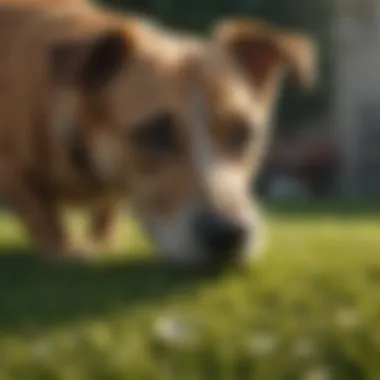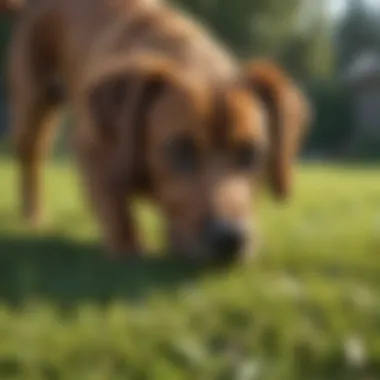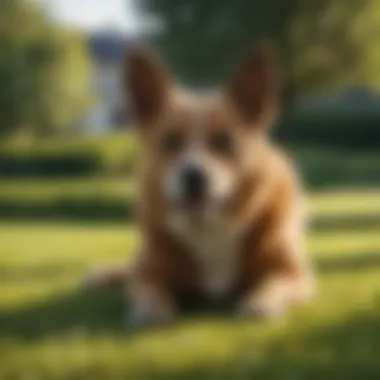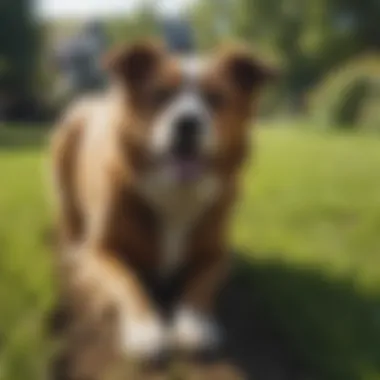Mastering Dog Urine Patch Repair for Healthy Lawns


Intro
Dog ownership brings immense joy but also unique challenges, particularly when it comes to maintaining a healthy lawn. Dog urine can lead to patchy and unsightly areas in gardens and yards. Understanding how to effectively repair these patches is crucial for homeowners and gardening enthusiasts. This discussion delves into various methods for assessing lawn damage caused by dog urine and the techniques for effective repair. Not only will this guide offer practical solutions but also promote sustainable practices that ensure long-term lawn health.
Latest Trends in Agriculture
Overview of Current Trends
In the context of lawn care and home gardening, recent trends highlight a growing awareness of environmentally friendly practices. Homeowners now seek solutions that support sustainability while addressing specific issues like dog urine damage. Organic fertilizers and eco-friendly products have gained popularity. This trend aligns with a broader shift in agriculture, where sustainable techniques are favored over traditional methods.
Impact of Technology on Farming Practices
The influence of technology on gardening cannot be overstated. Innovations such as soil sensors and moisture monitors help homeowners understand the needs of their lawns better. These devices enable quick assessment of lawn conditions and inform repair strategies for urine patches.
"The adoption of technology facilitates more informed decisions in home gardening, offering a pathway to healthier lawns."
Sustainable Practices: Towards a Greener Future
Importance of Sustainability in Agriculture
Sustainability in lawn care is more than a trend; it is a necessary approach. Using environmentally friendly practices ensures that lawns remain healthy without harming the ecosystem. Dog owners can adopt strategies that minimize chemical treatments, subsequently reducing potential harm to pets and local wildlife.
Methods for Sustainable Farming
To enhance lawn recovery from dog urine damage, certain sustainable methods may be applied:
- Use natural soil amendments, like compost, to improve soil structure.
- Select grass varieties that are more resistant to urine, such as tall fescue.
- Implement regular lawn aeration to promote drainage and recovery.
Gardening Techniques and Tips
Essential Gardening Tools and Equipment
Having the right tools is crucial for effective lawn repair. Key items include:
- Lawn aerator: Helps improve soil condition by allowing air circulation.
- Spreader: Ideal for evenly distributing seed and fertilizers.
- Rake: Essential for leveling soil and covering seeds post-application.
Seasonal Gardening Practices
Timing is key in lawn repair. It’s important to repair dog urine patches during the appropriate seasons. Spring and early fall are ideal for planting new grass seed, allowing sufficient growth before extreme temperatures arrive. In warmer seasons, maintaining adequate moisture levels is critical to aid recovery.
By understanding these trends and techniques, homeowners can effectively address dog urine patch issues while fostering sustainable gardening practices.
Foreword to Dog Urine Patch Repair
The topic of dog urine patch repair is essential for those who own pets and value their outdoor spaces, particularly lawns. Dog urine can create various challenges for homeowners who wish to maintain a lush and healthy yard. The significance of understanding this issue goes beyond aesthetics; it speaks to the balance between dog ownership and lawn care. A healthy lawn adds beauty to the environment, increases property value, and enhances the overall enjoyment of outdoor spaces.
Many dog owners encounter problems with dead or brown patches resulting from their pet's urine. However, recognizing the potential for damage and knowing how to address it effectively can save time, effort, and resources. This article aims to offer practical techniques and best practices that empower pet owners.
The repair of urine patches requires a multi-faceted approach. Key considerations include identifying the signs of damage, the type of grass that is most resistant to urine, and the proper methods of recovery. Together, these elements create a comprehensive understanding of lawn maintenance in the context of pet ownership. This introduction sets the groundwork for exploring specific repair strategies and sustainable practices that will benefit both lawns and the pets that inhabit them.
The Importance of a Healthy Lawn


Maintaining a healthy lawn is vital not only for aesthetic appeal but also for environmental benefits. A flourishing lawn improves air quality, reduces erosion, and provides a habitat for beneficial insects. Healthier grass enhances the leisure experience in gardens for both pets and humans. A resilient lawn can withstand wear from foot traffic, recover from climatic stress, and mitigate the impact of pet-related damage.
Healthy lawns offer a sanctuary for dogs to play and explore without the concern of damaging the flora. For homeowners looking to keep both pets and lawns thriving, a focus on cultivating and sustaining lawn health is essential. This entails continuous care, including adequate watering, proper mowing techniques, and periodic soil treatments. Clearly, investing effort into lawn health yields rewards that extend beyond the immediate landscape aesthetics.
Understanding Dog Urine Damage
The mechanics of how dog urine affects grass is integral to addressing the problem effectively. Dog urine contains high levels of nitrogen, salts, and other compounds that can lead to toxicity in lawn areas. While these components are essential nutrients for grass, excessive concentration can be harmful. When dogs urinate on grass, they deposit these compounds in concentrated amounts, leading to visible lawn damage.
Different grass types respond to this damage differently. Some may show resistance to urine, while others do not recover as readily. When a dog frequents particular spots, the repeated exposure can lead to specific localized damage, often in the form of yellow or brown patches. A clear understanding of the chemistry of dog urine and its effects on various grass species aids homeowners in managing and mitigating potential harm.
"Understanding the composition of dog urine is key to formulating effective patch repair strategies."
By recognizing the unique properties of their dog's urine and their lawn's specific needs, homeowners can take proactive steps to protect their yards while maintaining their canine companions' happiness.
Assessing Lawn Damage
Assessing lawn damage is a critical first step in the process of repairing patches caused by dog urine. By understanding the specific ways in which urine can affect grass, homeowners can make informed decisions about the necessary actions to restore their lawns. This assessment not only allows for targeted solutions but also helps to establish a baseline for future maintenance. Effective assessment requires careful observation to determine the extent of the damage, identify affected areas, and understand the underlying causes.
Identifying Urine Patches
Identifying urine patches involves searching for the telltale signs left on the lawn. A urine patch usually appears as a yellow or brown spot surrounded by an otherwise healthy green lawn. Dogs typically urinate in the same locations, leading to concentrated areas of damage. When assessing your lawn, it’s essential to look for different sizes and shapes of these patches. Not all patches will be uniform, as the size can vary based on factors like the amount of urine and the time of exposure. Regularly inspecting your grass can help pinpoint new patches early, making them easier to manage before extensive damage occurs.
Analyzing Grass Types Affected
Different grass types have varying levels of tolerance to dog urine. Some varieties, like Kentucky bluegrass, tend to recover better after being damaged. Others, such as fescue, may show more severe damage. Analyzing the types of grass in your lawn and how they respond to urine is essential in formulating a repair strategy. It is helpful to have a mix of grass types that can balance each other out, particularly if some are more resistant to urine damage. Consider cataloging the grasses present on your lawn to identify which areas may require special attention or alternative solutions.
Determining the Severity of Damage
Assessing the severity of damage from dog urine is necessary for a tailored response. Damage can range from mild discoloration to complete grass death, depending on factors like the frequency of urination and the dog's size. A thorough damage assessment might include checking the root system and soil health in the affected areas. If the grass has entirely died, it may indicate that the soil has also been impacted. Understanding severity helps in deciding if immediate corrective action is possible or if long-term rehabilitation strategies are needed. In some cases, you might need to explore soil amendments or reseeding to encourage growth in severely damaged areas.
"The first step in addressing lawn issues is accurate assessment. This helps in choosing the right techniques for repair, ultimately leading to healthier grass."
By carefully assessing lawn damage, homeowners can address specific issues and create a healthier environment for their pets and grass to thrive. This foundational step is key to maintaining a vibrant and resilient lawn.
Techniques for Repairing Urine Patches
Repairing dog urine patches is crucial for maintaining a healthy and visually appealing lawn. These techniques not only address existing damage but also promote resilience against future urine-related issues. As homeowners become increasingly aware of lawn health, effective strategies for repair are invaluable. The right approach can ensure the longevity of a lawn and enhance its resilience.
Immediate Response Strategies
Taking immediate action after noticing urine patches can significantly mitigate damage. Quick responses help to neutralize the effects of urine on grass. First, water the area thoroughly. This dilutes the nitrogen concentration in the urine, reducing its harmful impact on the grass. A simple rule is to use a hose or sprinkler to evenly saturate the affected patch.
Additionally, applying a mixture of water and vinegar can be effective. Vinegar helps to balance the pH, combating the alkaline effects of urine. This short-term remedy aids grass recovery while minimizing long-term damage.
Soil Amendments and Lawn Fertilizers
After the immediate response, consider soil amendments. Improving soil quality can enhance the lawn's recovery and overall health. Adding organic compost increases nutrients and promotes beneficial microbial activity. Additionally, gypsum can help to alleviate any soil compaction caused by dog urine. Gypsum also aids in improving drainage, which is essential for the recovery of grass.
Choosing the right lawn fertilizer is equally important. Look for those formulated for pet damage. These fertilizers contain specific nutrients that foster growth in areas impacted by urine. Applying them according to package instructions can lead to a greener and denser lawn.
Reseeding the Affected Areas


Once immediate strategies are applied, reseeding should be the next step. Selecting quality grass seeds designed for the local climate is vital. For instance, Kentucky bluegrass and perennial ryegrass are often good choices due to their adaptability. Reseeding involves lightly covering the affected area with seeds and then ensuring the seeds are watered consistently.
To boost the success rate of reseeding, consider using a seed starter fertilizer. This provides the necessary nutrients during the critical germination period. Covering the area with a thin layer of straw can also protect the seeds from birds and promote moisture retention.
Using Patch Repair Kits
Patch repair kits are an option for those seeking convenience. These kits generally contain a mix of grass seed, fertilizer, and soil. Using a patch repair kit simplifies the repair process, as they are specifically formulated for restoring damaged areas.
To utilize these kits, follow the provided instructions closely. Spreading the mixture evenly and covering it lightly with soil can lead to successful recovery. Regular watering is crucial in the initial stages after application.
"Efficient techniques for repairing urine patches can lead to a thriving lawn that withstands the challenges posed by pet ownership."
In summary, repairing urine patches involves immediate corrective actions, soil enrichment, reseeding, and using repair kits as needed. Each step is part of a comprehensive approach to maintain a robust and vibrant lawn.
Long-Term Lawn Management Strategies
Proper management of lawns affected by dog urine is crucial for sustaining their health and beauty. Implementing long-term strategies not only addresses the immediate damage but also prevents future issues. It is essential to develop comprehensive practices that cater to both the soil and grass types present in the lawn. By enriching soil, selecting the right grass varieties, and adhering to regular maintenance, homeowners can create a resilient landscape that withstands the challenges posed by pet ownership.
Promoting Soil Health
Soil is the foundation of a lush lawn. When addressing dog urine damage, it is vital to focus on enhancing soil health. Healthy soil promotes root growth and improves water retention, allowing grass to recover effectively from urine exposure.
Here are some strategies for promoting soil health:
- Testing Soil pH: Regular soil tests can identify pH levels, which influence nutrient availability. Aim for a pH between 6.0 and 7.0 for optimal grass growth.
- Adding Organic Matter: Incorporate compost or well-rotted manure into the soil. This improves structure, fertility, and water-holding capacity.
- Applying Soil Amendments: Based on soil tests, consider adding amendments such as lime or sulfur to balance soil chemistry. This can lead to better nutrient uptake by grass roots.
"Healthy soil is vital for a thriving lawn, especially when facing the challenges posed by dog urine."
Taking these steps can strengthen the grass, enabling it to resist and recover from damage more efficiently.
Selecting Urine-Resistant Grass Varieties
Choosing the right type of grass is a fundamental aspect of long-term lawn management. Certain grass species are more resilient to the effects of dog urine than others. Selecting urine-resistant varieties can provide a more durable lawn, reducing the frequency and severity of damage.
Some grass types to consider include:
- Tall Fescue: Known for its drought tolerance and adaptability, this grass can withstand urine exposure better than many of its counterparts.
- Bermudagrass: This grass offers robust growth patterns and is generally resistant to urine damage, making it suitable for sunny areas.
- Kentucky Bluegrass: While this grass may require more care, it can recover quickly from urine damage if managed properly.
These grass varieties not only endure the challenges of dog urine but also maintain aesthetic appeal, contributing to a healthy lawn.
Regular Lawn Maintenance Habits
Adopting a routine lawn care schedule enhances the overall health and resilience of grass under duress from dog urine. Regular maintenance ensures that grass remains thick and vigorous, creating a barrier against damaging substances. Establishing consistent practices can mitigate the adverse effects of urine over time.
Consider the following maintenance habits:
- Mowing: Keep grass at an optimal height. Mowing at the right height allows for better photosynthesis and improves the lawn's ability to recover from damage.
- Watering: Ensure the lawn gets enough water, especially in times of heat or drought. Watering helps dilute the concentration of urine in the soil, reducing its harmful effects.
- Fertilizing: Use a balanced fertilizer to provide essential nutrients throughout the growing season. This promotes healthy grass growth that can better withstand stress.
By maintaining regular lawn care habits, homeowners can foster an environment where grass thrives, minimizing damage from dog urine.
Implementing these long-term strategies is vital for achieving a sustainable and manageable lawn. Each of these practices contributes to a stronger and healthier landscape, allowing pet owners to enjoy both their pets and their gardens.


Behavioral Modifications for Pets
Addressing dog urine damage effectively involves not just remedial measures for the lawn, but also altering the behavior of pets. This section discusses various behavioral modifications that can help reduce the impact of dog urine on gardens and lawns. These modifications are essential as they can lead to sustainable solutions that naturally mitigate damage over time while improving the overall quality of the lawn.
Training Dogs to Urinate in Designated Areas
One of the most effective strategies in managing dog urine damage is training pets to relieve themselves in specific areas. Training dogs to urinate in designated spots can significantly reduce the concentration of urine in any given area of the lawn, thus minimizing damage.
Implementing this practice requires several steps:
- Selecting a Designated Area: Choose an area in your yard that is less visible or out of the way. Ensure that this area is appropriate and easy for your dog to access.
- Establishing a Routine: Dogs respond well to routines. Establish a regular schedule for taking your dog out. Consistency is key.
- Positive Reinforcement: Utilize treats or praise to reward your dog whenever they successfully use the designated area. This reinforcement encourages your dog to associate the area with positive experiences.
- Redirecting: When your dog begins to urinate in another area, gently redirect them to the designated spot. Continued redirection helps reinforce the behavior.
Training takes time, but the benefits are long-lasting. Not only does this practice protect the lawn, but it can also foster a stronger bond between you and your pet.
Utilizing Dog Rocks and Other Solutions
In addition to training, certain products can help manage nitrogen levels in dog urine. One such product is Dog Rocks, which may help reduce the harmful effects of urine on grass.
- What Are Dog Rocks?: Dog Rocks are natural volcanic rocks that, when placed in a dog's water bowl, can help filter out impurities like nitrates and ammonia. This can result in less damaging urine.
- Effectiveness: While claims vary, many pet owners have noted reduced lawn damage after using these rocks consistently. However, it's important to keep in mind that results may depend on the specific dog's dietary habits and health.
- Consider Other Solutions: Alongside Dog Rocks, there are other options to explore. For instance, certain supplements claim to alter the pH of urine, potentially neutralizing its effects on lawns. Consult with a veterinarian before introducing any new product to your dog's diet, as health implications must be considered.
"Behavioral modifications in pets not only protect the lawn but also contribute to the happiness of pets and their owners alike."
Environmental Considerations
Addressing environmental considerations in the context of dog urine patch repair is essential for maintaining a healthy lawn ecosystem. Not only does effective management of dog urine patches contribute to the aesthetics of a yard, but it also impacts broader ecological factors. Understanding these considerations enables homeowners and gardening enthusiasts to cultivate a sustainable environment for both their pets and native flora.
Impact of Dog Urine on Lawn Ecosystems
Dog urine can have significant ramifications for lawn ecosystems. It consists largely of nitrogen, which in low amounts can promote healthy grass growth. However, high concentrations resulting from concentrated urination can lead to toxic stress for nearby plants. This stress can manifest as yellowing or browning patches on the grass, which diminishes overall yard quality. Additionally, certain species of grass may be more susceptible to urine damage than others, creating an uneven landscape that could disrupt local biodiversity.
Understanding these impacts helps homeowners grasp the urgency of proper lawn care. They can prioritize repairs not just for the sake of appearance, but to support the resilience of their lawn's ecosystem.
Sustainable Practices in Lawn Care
Employing sustainable practices in lawn care is not merely about aesthetics but also about fostering an environment that can thrive long-term. Here are key strategies to consider:
- Soil Testing: Regularly testing soil can help identify nutrient imbalances that could worsen the effects of dog urine. This allows for targeted amendments that position the lawn for better health.
- Composting: Utilizing compost can enrich the soil while helping to absorb and mitigate some of the nitrogen spikes from dog urine.
- Using Organic Fertilizers: Transitioning to organic fertilizers reduces chemicals that may harm soil health and enhances the lawn's natural resilience against urine damage.
- Natural Barriers and Designs: Landscaping can be modified to include natural barriers, such as native shrubs, that serve to absorb excess nutrients and filter runoff.
Engaging in proactive and sustainable lawn care measures not only addresses existing damage but also fosters a thriving ecosystem conducive to both plant health and pet play.
The End and Future Directions
In summary, the topic of dog urine patch repair is crucial for maintaining a healthy and visually appealing lawn. The insights provided throughout this article highlight various methods and strategies designed to mitigate the detrimental effects that dog urine can have on grass. Understanding the specific causes and recognizing the underlying mechanisms contributes significantly to effectively repairing damaged sections and preventing recurrence.
Summarizing Key Repair Techniques
A comprehensive approach to repairing urine patches includes several effective techniques. These encompass immediate response strategies, utilizing soil amendments, reseeding the area, and employing patch repair kits. Each repair technique addresses a different aspect of lawn recovery:
- Immediate Response Strategies: This involves quick action to dilute the area and prevent further damage. Watering the affected prey swiftly after urination can reduce nitrogen concentration.
- Soil Amendments and Lawn Fertilizers: Adjusting soil quality through amendments is essential as it improves grass health. Incorporating gypsum or other products can help counteract the harmful effects of urine.
- Reseeding the Affected Areas: Reseeding with dog-resistant grass varieties enhances the lawn's resilience against future incidents. Fescue and ryegrass are common choices for better tolerance.
- Using Patch Repair Kits: These kits are commercially available and designed specifically to assist in repairing urine patches. They provide a blend of nutrients and seeds compactly packaged for convenience.
Note: Regular assessments of your lawn can help identify damages early and improve the repair process.
Encouraging Ongoing Lawn Care Practices
Maintaining a robust lawn requires consistent care and attention. Encouraging ongoing practices can benefit not only the health of the grass but also the overall landscape. Here are some recommendations:
- Regular Lawn Watering: Consistent watering is necessary, especially during dry seasons. This not only helps wash away concentrated urine but also provides the grass with hydration.
- Periodic Soil Testing: Conducting soil tests will give detailed insights into pH and nutrient levels, allowing homeowners to adjust their fertilization strategies accordingly.
- Mowing Practices: Keeping grass at an optimal height supports vigorous growth and helps the lawn recover from stress more effectively.
- Behavioral Modification for Dogs: Training dogs to use specific areas can significantly lower damage to the primary lawn sections.
By adopting these methods and understanding future implications regarding urine patch repair, homeowners can contribute to the sustainability of their landscapes while accommodating their pets. The information provided herein serves as a foundational guideline for enhancing lawn health and aesthetics.







